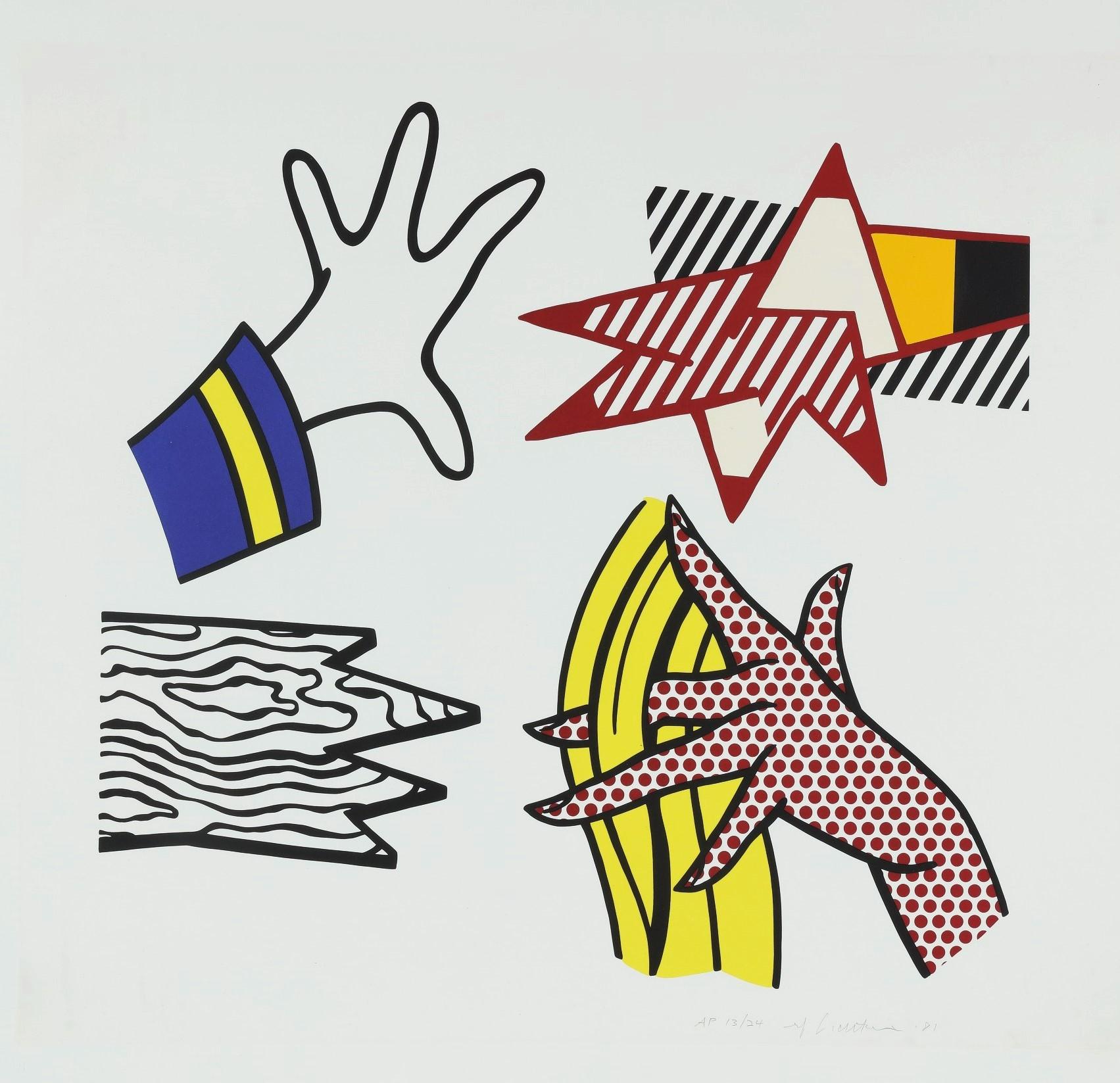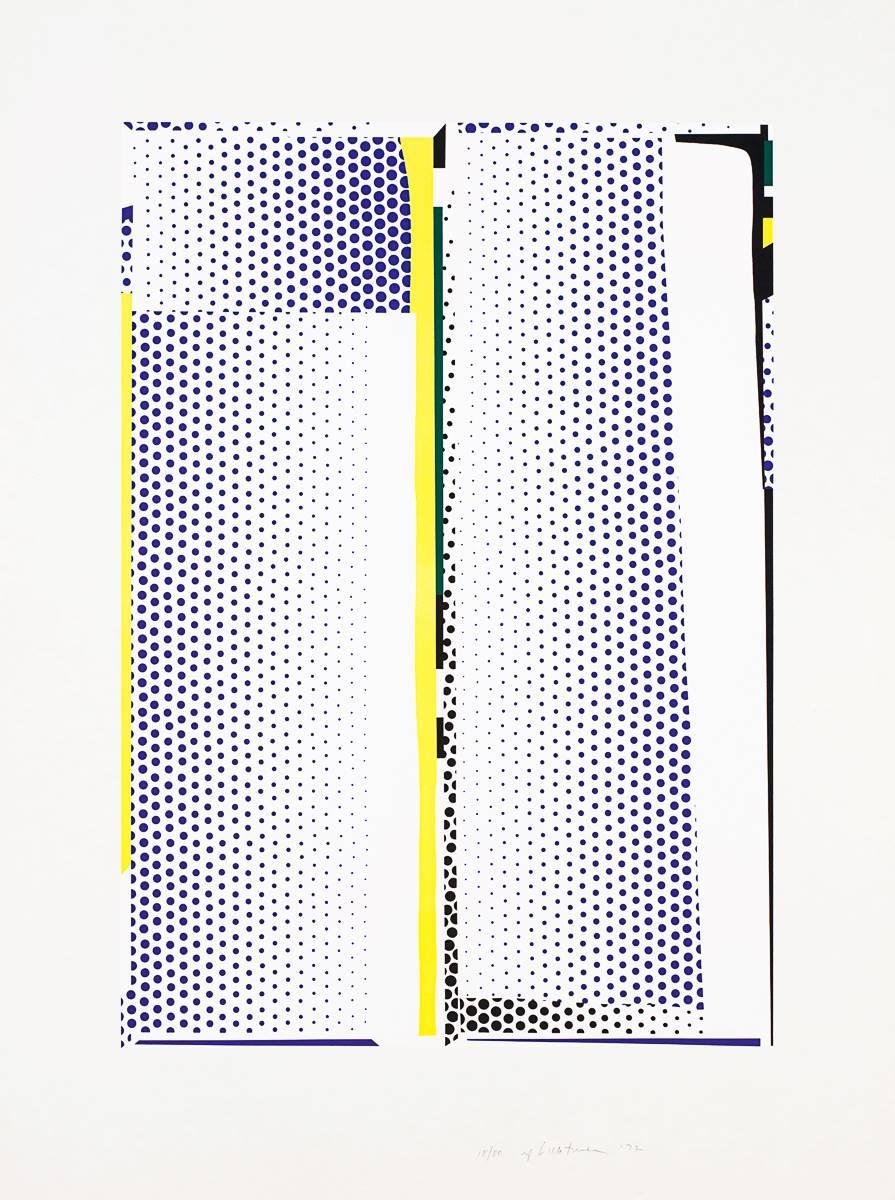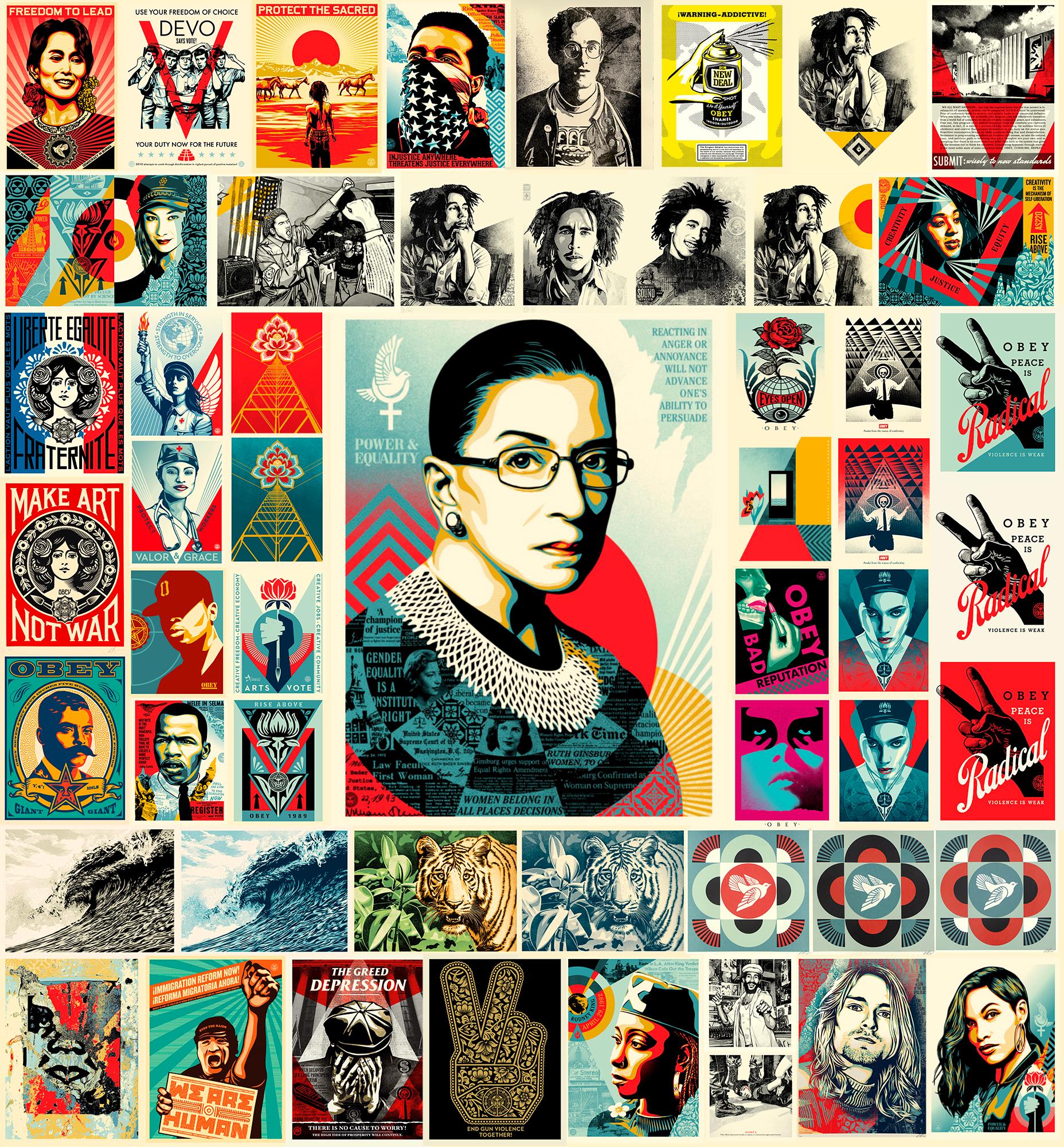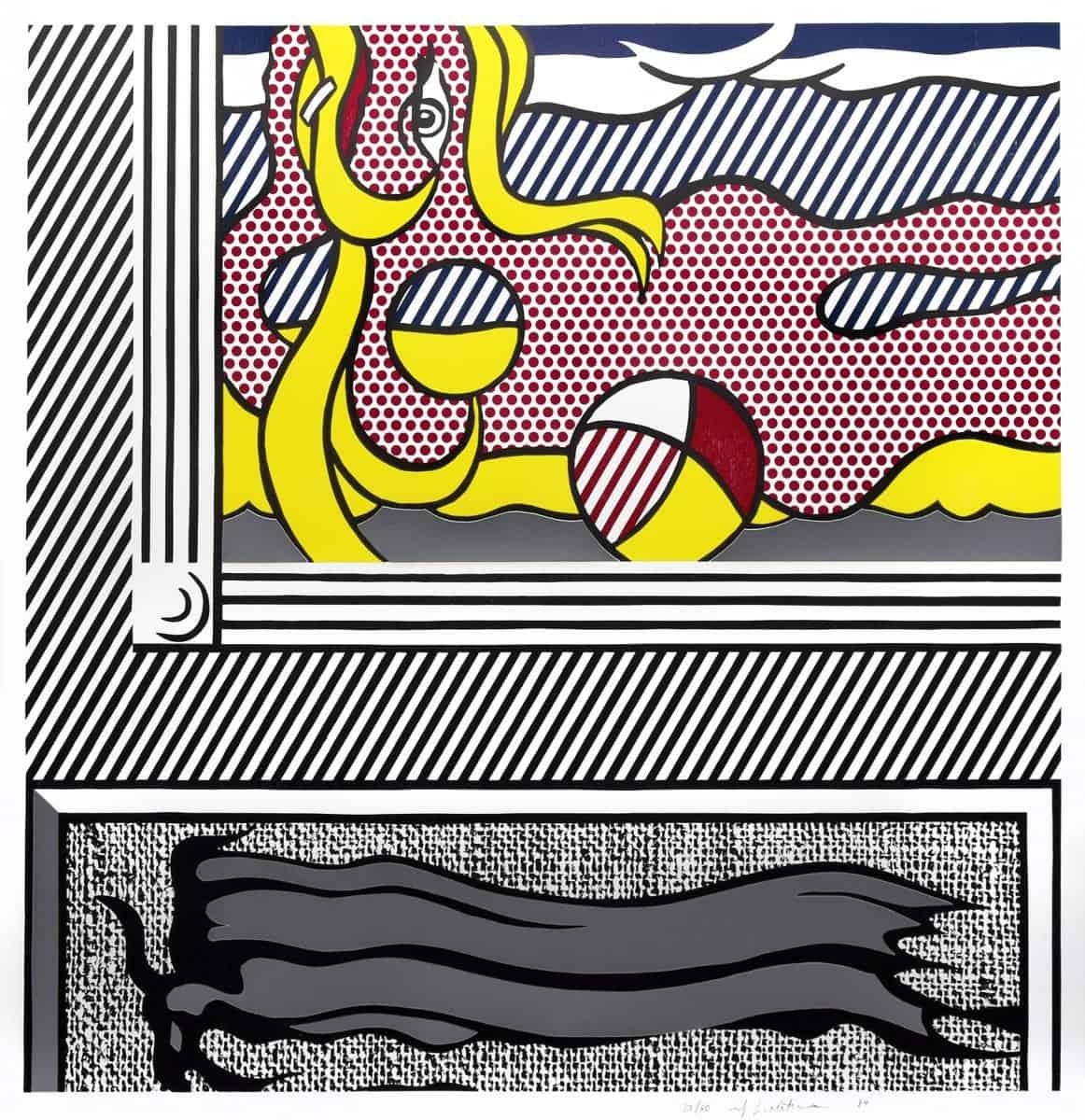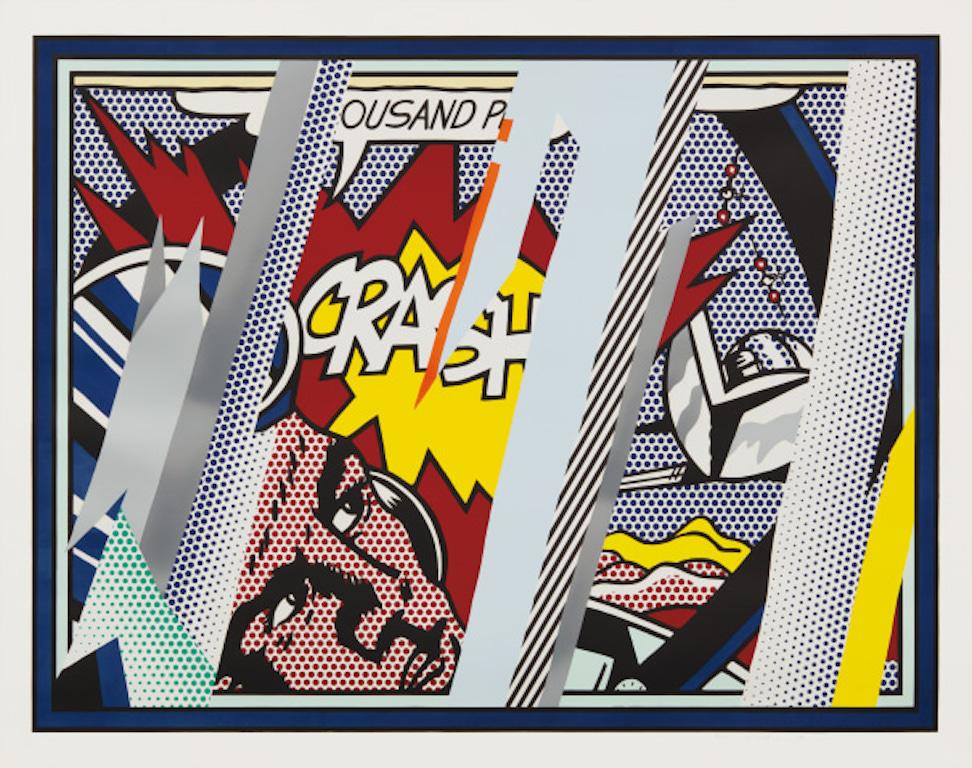Roy LichtensteinMirror #7 (C.112), 19721972
1972
About the Item
- Creator:Roy Lichtenstein (1923 - 1997, American)
- Creation Year:1972
- Dimensions:Height: 46 in (116.84 cm)Width: 33 in (83.82 cm)
- Medium:
- Movement & Style:
- Period:
- Condition:generally excellent condition with some minor handling dents, soiling in the margin, scattered scuffs and corner tip wear; sheet is slightly toned.
- Gallery Location:Greenwich, CT
- Reference Number:
Roy Lichtenstein
Roy Lichtenstein is one of the principal figures of the American Pop art movement, along with Andy Warhol, James Rosenquist, Claes Oldenburg and Robert Rauschenberg.
Drawing inspiration from comic strips, Lichtenstein appropriated techniques commercial printing in his paintings, introducing a vernacular sensibility to the visual landscape of contemporary art. He employed visual elements such as the halftone dots that comprise a printed image, and a comic-inspired use of primary colors gave his paintings their signature “Pop” palette.
Born and raised in New York City, Lichtenstein enjoyed Manhattan’s myriad cultural offerings and comic books in equal measure. He began painting seriously as a teenager, studying watercolor painting at the Parsons School of Design in the late 1930s, and later at the Art Students League, where he worked with American realist painter Reginald Marsh. He began his undergraduate education at Ohio State University in 1940, and after a three-year stint in the United States Army during World War II, he completed his bachelor’s degree and then his master’s in fine arts. The roots of Lichtenstein’s interest in the convergence of high art and popular culture are evident even in his early years in Cleveland, where in the late 1940s, he taught at Ohio State, designed window displays for a department store and painted his own pieces.
Working at the height of the Abstract Expressionist movement in the 1950s, Lichtenstein deliberately eschewed the sort of painting that was held in high esteem by the art world and chose instead to explore the visual world of print advertising and comics. This gesture of recontextualizing a lowbrow image by importing it into a fine-art context would become a trademark of Lichtenstein’s artistic style, as well as a vehicle for his critique of the concept of good taste. His 1963 painting Whaam! confronts the viewer with an impact scene from a 1962-era issue of DC Comics’ All American Men of War. Isolated from its larger context, this image combines the playful lettering and brightly colored illustration of the original comic with a darker message about military conflict at the height of the Cold War. Crying Girl from the same year featured another of Lichtenstein’s motifs — a woman in distress, depicted with a mixture of drama and deadpan humor. His work gained a wider audience by creating a comic-inspired mural for the New York State Pavilion of the 1964 World's Fair, he went on to be represented by legendary New York gallerist Leo Castelli for 30 years.
In the 1970s and ’80s, Lichtenstein experimented with abstraction and began exploring basic elements of painting, as in this 1989 work Brushstroke Contest. In addition to paintings in which the brushstroke itself became the central subject, in 1984 he created a large-scale sculpture called Brushstrokes in Flight for the Port Columbus International Airport in Ohio. Still Life with Windmill from 1974 and the triptych Cow Going Abstract from 1982 both demonstrate a break from his earlier works where the subjects were derived from existing imagery. Here, Lichtenstein paints subjects more in line with the norms of art history — a pastoral scene and a still life — but he has translated their compositions into his signature graphic style, in which visual elements of printed comics are still a defining feature.
Lichtenstein’s work is represented in the collections of the Metropolitan Museum of Art, the Museum of Modern Art, Tate Modern, and many others. He was awarded National Medal of Arts in 1995, two years before he passed away.
Find a collection of Roy Lichtenstein prints, drawings and more on 1stDibs.
- ShippingRetrieving quote...Ships From: Las Vegas, NV
- Return PolicyA return for this item may be initiated within 3 days of delivery.
- Mirror #9 (C.114, Mirror Series), 1972By Roy LichtensteinLocated in Greenwich, CTMirror #9 (C.114) from the Mirror Series is a screenprint and lithograph on paper, 30 x 21.18 inches, signed and dated 'rf Lichtenstein '72' lower center margin and framed in a contemporary white frame. Catalog - Corlett, The Prints of Roy Lichtenstein - A Catalogue Raisonne 1948 - 1997, Hudson Hills Press, NY and National Gallery of Art, Washington, D.C., 2002, pg.126, #114. About Lichtenstein’s Mirror Series (taken from Corlett): Mirrors were an important subject in Lichtenstein’s paintings and prints of the early 1970s. From late 1969 to 1972 he painted over forty canvases depicting this subject. The first print was in 1970, with Twin Mirrors (cat. no.102) for the Guggenheim Museum. In 1972 he also produced Mirror (cat. No. 115) at Styria Studio, in addition to this Gemini G.E.L. series of nine prints. In the mid-seventies he took up the subject in sculpture, and he returned to it in prints as recently 1990, with Mirror (cat. No 246). In addition, he has often explored the related theme of reflections, incorporating them in various paintings and in several print series: Reflections (1990; cat. Nos. 239 – 245), Interiors (1990, published 1991; cat. nos. 247 – 54), and Water Lilies (1992; cat. nos. 261 – 66). This Gemini group (catalog nos. 1-6 - 114) utilizes lithography, screenprint, line-cut, and embossing... In an interview with Lawrence Alloway, Lichtenstein noted: “You know, I am always impressed by how artificial things look – like descriptions of office furniture in newspapers. It is the most dry kind of drawing, as in the Mirrors. They really only look like mirrors if someone tells you they do. Only once you know that, they may be moved as far as possible from realism, but you want it to be taken for realism. It becomes as stylized as you can get away with, in an ordinary sense, not stylish.” As Jack Cowart has commented: “One would not actually stand in front of a Lichtenstein Mirror...Category
20th Century Pop Art Prints and Multiples
MaterialsLithograph, Screen
- Twin Mirrors (C.102), 1970By Roy LichtensteinLocated in Greenwich, CTTwin Mirrors (C.102) is a screenprint on paper created for the Guggenheim Museum in 1970, 35 x 21 inches image size, signed and dated 'rf Lichtenstein '70' lower right and numbered 94/250 lower left (from the edition of 250 plus an unknown number of artist proofs). Framed in a contemporary white frame. Catalog - Corlett, The Prints of Roy Lichtenstein - A Catalogue Raisonne 1948 - 1997, Hudson Hills Press, NY and National Gallery of Art, Washington, D.C., 2002, pg.118, #102. About Lichtenstein’s Mirror...Category
20th Century Pop Art Prints and Multiples
MaterialsPaper, Screen
- Acid RainBy Kenny ScharfLocated in Greenwich, CTAcid Rain is a screenprint on paper in unique, trial-proof colors, 32 x 40" sheet size, signed and numbered in the lower right margin ‘TP16/40 Kenny Scharf,’ and framed in a contemp...Category
1980s Pop Art Prints and Multiples
MaterialsScreen, Paper
- Space BallsBy Kenny ScharfLocated in Greenwich, CTSpace Balls is a unique, trial-proof screenprint on paper, 32 x 40" sheet size, signed and numbered lower right margin ‘TP14/40 Kenny Scharf,’ and framed in a contemporary, white mou...Category
1980s Pop Art Prints and Multiples
MaterialsScreen, Paper
- Caucus (Leo Castelli 90th Birthday Portfolio), 1997By Robert RauschenbergLocated in Greenwich, CTCaucus is an offset lithograph on paper with an image size of 37 x 27 inches, framed in a contemporary, silver-tone frame 50.5 x 40.25 inches. From the edition of 190 - the art is si...Category
20th Century Pop Art Prints and Multiples
MaterialsPaper, Lithograph
- SexBy Ed RuschaLocated in Greenwich, CTSex is a lithograph on paper, image size 28 x 35.5 inches, signed 'Ruscha' lower right and annotated 20/30 lower left, framed in a contemporary wood frame. From the edition of 33, n...Category
20th Century Pop Art Prints and Multiples
MaterialsLithograph, Paper
- Study of HandsBy Roy LichtensteinLocated in New York, NYCreated in 1981 as an original lithograph with screen-printing, Roy Lichtenstein’s, Study of Hands is hand-signed in pencil, dated and numbered, measuring 31 ¼ x 32 ¾ in. (79.5 x 83....Category
20th Century Pop Art Figurative Prints
MaterialsLithograph, Screen
- Shepard Fairey Screen-prints: collection of 60 works (2009-2022)By Shepard FaireyLocated in NEW YORK, NYShepard Fairey Screen-prints: collection of 60 works: 2009-2022: A rare assemblage of 60 hand-signed Shepard Fairey screen-prints; collected over a near 15 year period (2009-2022). Notable imagery includes: Bob Marley, Keith Haring, Ruth Bader Ginsburg, Kurt Cobain, as well as a series of vivid anti-war pieces defining the artist's practice (title list found further below). Each very well-preserved. Medium: Screen-prints on heavy paper. 2009-2022 (see below for a list of titles & years). Dimensions ranging from: 19.5 x 16 inches to 24x36 inches. Each work is hand-signed; works are either numbered from their respective main editions or notated 'AP' (see last listing image); a few or several works are signed, but not numbered. Excellent overall condition with the exception of perhaps some minor signs of handling on a few examples. Provenance: Private collection New York via Shepard Fairey. Listing images beginning with image 2 represent the actual works. These works will be shipped flat using protective materials. Please feel free to contact us with any additional questions. Titles & Years: OCEAN TODAY...Category
21st Century and Contemporary Pop Art Abstract Prints
MaterialsLithograph, Screen
- Two Paintings: Beach Ball, from Paintings SeriesBy Roy LichtensteinLocated in Palo Alto, CARoy Lichtenstein Two Paintings: Beach Ball, from Paintings Series, 1984 uses his signature patterns and lines to create various visual implications. Straight lines are used to emphas...Category
1980s Pop Art Abstract Prints
MaterialsLithograph, Screen, Woodcut
- Pop Art Aspen Road Sign D'arcangelo Silkscreen Chiron Press Vintage Art PosterLocated in Surfside, FLAllan D'Arcangelo (American/New York, 1930-1998), "Aspen Center of Contemporary Art", 1967 silkscreen, hand signed in pencil, dated, numbered "45/200" and blind stamped "Chiron Press, New York, NY" 32 in. x 24 in. Allan D'Arcangelo (1930-1998) was an American artist and printmaker, best known for his paintings of highways and road signs that border on pop art and minimalism, precisionism, Abstract illusionism and hard-edge painting, and also surrealism. His subject matter is distinctly American and evokes, at times, a cautious outlook on the future of this country. Allan D'Arcangelo was the son of Italian immigrants. He studied at the University of Buffalo from 1948–1953, where he got his bachelor's degree in history. After college, he moved to Manhattan and picked up his studies again at the New School of Social Research and the City University of New York, City College. At this time, he encountered Abstract Expressionist painters who were in vogue at the moment. After joining the army in the mid 1950s, he used the GI Bill to study painting at Mexico City College from 1957–59, driving there over 12 days in an old bakery truck retrofitted as a camper. However, he returned to New York in 1959, in search of the unique American experience. It was at this time that his painting took on a cool sensibility reminiscent of Roy Lichtenstein and Andy Warhol. His interests engaged with the environment, anti-Vietnam War protests, and the commodification and objectification of female sexuality. D'Arcangelo first achieved recognition in 1962, when he was invited to contribute an etching to The International Anthology of Contemporary Engraving: America Discovered; his first solo exhibition came the next year, at the Thiebaud Gallery in New York City. In 1965 he contributed three screenprints to Original Edition's 11 Pop Artists portfolio. By the 1970s, D'Arcangelo had received significant recognition in the art world. He was well known for his paintings of quintessentially American highways and infrastructure, and in 1971 was commissioned by the Department of the Interior to paint the Grand Coulee Dam in Washington state. However, his sense of morality always trumped his interest in art world fame. In 1975, he decided to quit the gallery that had been representing him for years, Marlborough Gallery, because of the way they handled Mark Rothko legacy. D'Arcangelo rejected Abstract Expressionism, though his early work has a painterly and somewhat expressive feel. He quickly turned to a style of art that seemed to border on Pop Art and Minimalism, Precisionism and Hard-Edge painting. Evidently, he didn't fit neatly in the category of Pop Art, though he shared subjects (women, signs, Superman) and techniques (stencil, assemblage) with these artists.He turned to expansive, if detached scenes of the American highway. These paintings are reminiscent of Giorgio de Chirico-though perhaps not as interested in isolation-and Salvador Dali-though there is a stronger interest in the present and disinterest in the past. These paintings also have a sharp quality that is reminiscent of the precisionist style, or more specifically, Charles Sheeler. 1950s, Before D'Arcangelo returned to New York, his style was roughly figurative and reminiscent of folk art. During the early 1960s, Allan D'Arcangelo was linked with Pop Art. "Marilyn" (1962) depicts an illustrative head and shoulders on which the facial features are marked by lettered slits to be "fitted" with the eyebrows, eyes, nose and mouth which appear off to the right in the composition. In "Madonna and Child," (1963) the featureless faces of Jackie Kennedy and Caroline are ringed with haloes, enough to make their status as contemporary icons perfectly clear. Select Exhibitions: Fischbach Gallery, New York, Ileana Sonnabend Gallery, Paris, Gallery Müller, Stuttgart, Germany Hans Neuendorf Gallery, Hamburg, Germany Dwan Gallery...Category
1960s Pop Art Abstract Prints
MaterialsLithograph, Screen
- Reflections on CrashBy Roy LichtensteinLocated in New York, NY1990 Lithograph, screenprint on paper and metalised PVC on paper S. 59 1/8 x 75 in. (150.2 x 190.5 cm) Edition of 68 Signed, dated and numbered in pencil, lower marginCategory
1990s Pop Art Abstract Prints
MaterialsPaper, Lithograph, Screen
- 1969-71 Abstract Minimalist Color Silkscreen Print Charles Hinman On The BoweryBy Charles HinmanLocated in Surfside, FLCharles Hinman On the Bowery, 1969 - 1971 silkscreen on Schoeller's Parole Paper, edition of 100 + 20 A.P. 25.5 x 25.5 inches, signed, numbered 21/100 Screenprint in color on wove paper Hand signed, published by Edition Domberger, Bonlanden, West Germany (with their blindstamp) Provenance: Collection of Tom Levine On the Bowery, 1971. The portfolio consists of nine screenprints in colors (one with mylar collage), on wove paper, by representative artists of the Pop Art period. Cy Twombly, Robert Ryman, Will Insley, Robert Indiana, Les Levine, John Willenbecher...Category
1960s Pop Art Abstract Prints
MaterialsScreen, Lithograph
